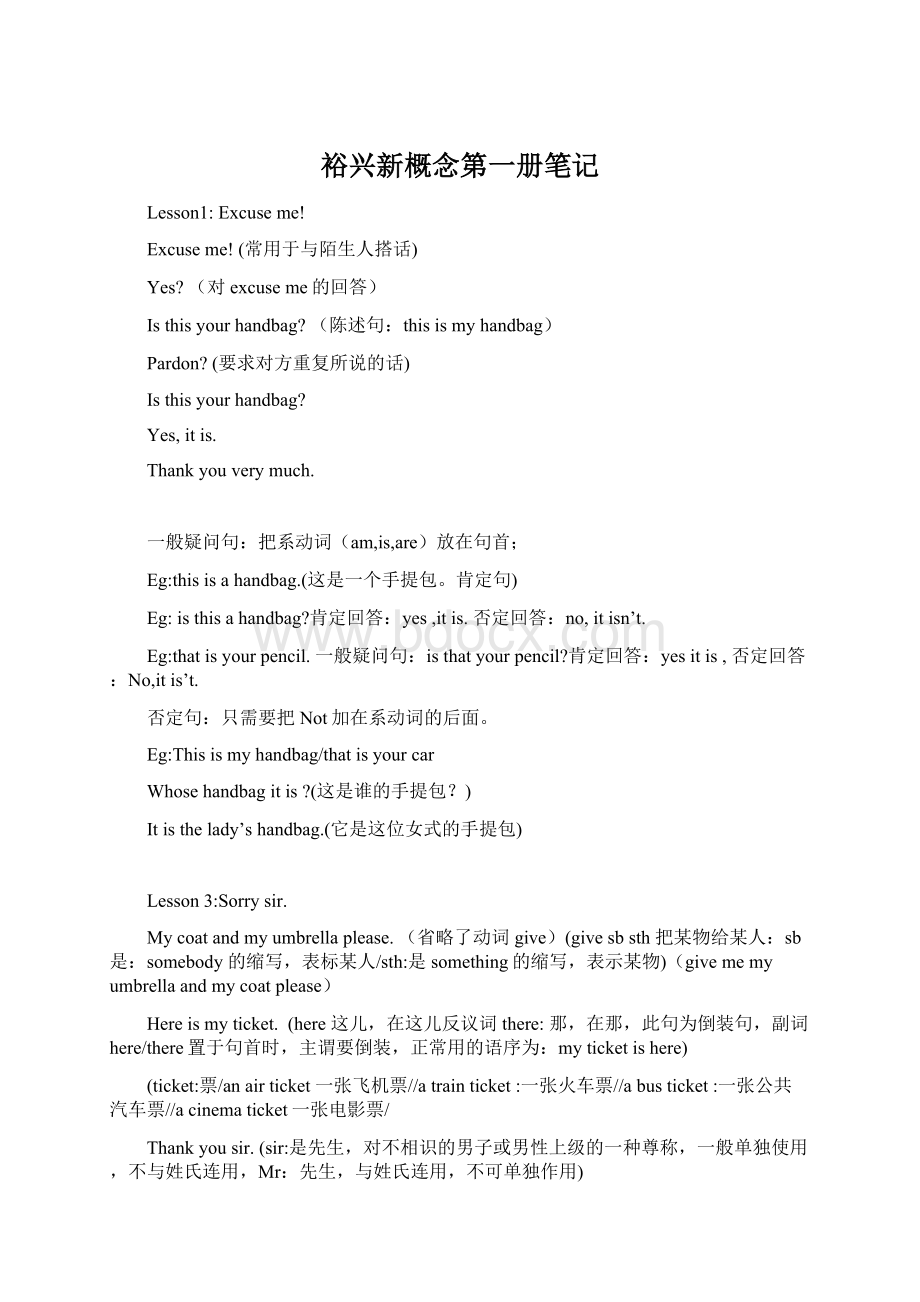裕兴新概念第一册笔记.docx
《裕兴新概念第一册笔记.docx》由会员分享,可在线阅读,更多相关《裕兴新概念第一册笔记.docx(83页珍藏版)》请在冰豆网上搜索。

裕兴新概念第一册笔记
Lesson1:
Excuseme!
Excuseme!
(常用于与陌生人搭话)
Yes?
(对excuseme的回答)
Isthisyourhandbag?
(陈述句:
thisismyhandbag)
Pardon?
(要求对方重复所说的话)
Isthisyourhandbag?
Yes,itis.
Thankyouverymuch.
一般疑问句:
把系动词(am,is,are)放在句首;
Eg:
thisisahandbag.(这是一个手提包。
肯定句)
Eg:
isthisahandbag?
肯定回答:
yes,itis.否定回答:
no,itisn’t.
Eg:
thatisyourpencil.一般疑问句:
isthatyourpencil?
肯定回答:
yesitis,否定回答:
No,itis’t.
否定句:
只需要把Not加在系动词的后面。
Eg:
Thisismyhandbag/thatisyourcar
Whosehandbagitis?
(这是谁的手提包?
)
Itisthelady’shandbag.(它是这位女式的手提包)
Lesson3:
Sorrysir.
Mycoatandmyumbrellaplease.(省略了动词give)(givesbsth把某物给某人:
sb是:
somebody的缩写,表标某人/sth:
是something的缩写,表示某物)(givememyumbrellaandmycoatplease)
Hereismyticket.(here这儿,在这儿反议词there:
那,在那,此句为倒装句,副词here/there置于句首时,主谓要倒装,正常用的语序为:
myticketishere)
(ticket:
票/anairticket一张飞机票//atrainticket:
一张火车票//abusticket:
一张公共汽车票//acinematicket一张电影票/
Thankyousir.(sir:
是先生,对不相识的男子或男性上级的一种尊称,一般单独使用,不与姓氏连用,Mr:
先生,与姓氏连用,不可单独作用)
Numberfive.(Number+基数:
one,two,three……表示第几,类似的用有:
pageone第一页, lessontwo:
第二课,daythree:
第三天)
Hereisyourumbrellaandyourcoat.(此句也是倒装句,下正常语序为:
yourumbrellaandyourcoatishere)(and表示“和”,是连词,连续两个并列成份,位置可以互换。
Eg:
myfatherandmymother.///
Thisisnotmyumbrella.
Sorrysir.
Isthisyourumbrella?
(此句为否定句,含有系动词的肯定句变成否定句时,在系动词的后面加:
“not”,eg:
:
thatisnotmyhouse/那不是我的房子)
No,itisn't.
Isthisit?
(it指yourumbrella,由于前面提到了unbrella,所以后面用it来代替,以免复。
)
Yes,itis.
Thankyouverymuch.
Lesson5:
Nicetomeetyou.
Goodmorning.
Goodmorning,Mr.Blake.
ThisisMissSophieDupont.(thisis+姓名:
是把一个人介绍给另一个人时用的句型,向别人介绍自已时用:
mynameis或者是Iam。
)
Sophieisanewstudent.
SheisaFrench.
Sophie,thisisHans.
HeisGerman.
Nicetomeetyou.(用于非正式的场合初次见面,回答:
nicetomeetyoutoo,正式厂合应该用:
howdoyoudo?
回答:
howdoyoudo.)
AndthisisNaoko.
She’s Japanese.
Nicetomeetyou.
AndthisisChang-woo.
He’sKorean.
Nicetomeetyou.
AndthisisLuming.
He’sChinese.
Nicetomeetyou.
AndthisisXiaohui.
She’sChinese,too.
Nicetomeetyou.
Lesson7:
Areyouateacher?
I’manewstudent.(areyouanewstudent?
你是一个新学生吗?
)
Myname’sRobert.
Nicetomeetyou.
Myname’sSophie.
AreyouFrench?
Yes,I’m.
AreyouFrench,too?
(too用在肯定句和疑问句中,在否定句中用either,//eg:
misssophieDupontisaFrench,too,这句是用在肯定句中。
//Isherhandbagred,too?
)
No,I’mnot.
Whatnationalityareyou?
I’mItalian.
Areyouateacher?
No,I’mnot.
What’syourjob?
(也可以用whatdoyoudo?
)
I’makeyboardoperator.
What’syourjob?
I’manengineer.
Lesson9:
Howareyoutoday?
Hello,Helen.
Hi,Steven.
Howareyoutoday?
(Howareyou是般用于朋友和相识的人见面时关于身体的一适中问候)
I’mverywell,Thankyou.
Andyou?
I’mfine,thanks.
HowisTony?
(也可用:
Howishe?
)
He’sfine,Thanks.
How’sEmma?
She’sverywell,too,Helen.
Goodbye,Helen.
Nicetoseeyou.(用于相互认识的人见面时打招呼用,初次见面时用:
Nicetomeetyou)
Nicetoseeyou,too,Steven.
Goodbye.
Lesson11:
Isthisyourshirt?
Whoseshirtisthat?
(也可用:
whoseisthatshirt?
)
Isthisyourshirt,Dave?
(也可用:
Isthisyours?
//yours是物主性代词,=yourshirt)
No,sir.
It’snotmyshirt.
Thisismyshirt.
Myshirtsblue.
IsthisshirtTim’s?
(Tim's表示Tim的,而shirt's表示shirtis的缩写)
Perhapsitis,sir.
Tim’sshirtswhite.
Tim!
Yes,sir.
Isthisyourshirt?
Yes,Sir.
Hereyouare.(eg:
canIborrowyourpen?
/我可以借你的笔吗?
/yes,ofcourse,Heryouare,当然可以,给你)(当别人在找某样东西时,而你指出某物在什么地方时可以用:
单数形式:
Hereitis//复数形式:
Heretheyare,Eg:
Doyouseemycoat?
/Hereitis.Wherearemykeys?
/Heretheyare)
Catch.
Thankyou,sir.
Lesson13:
Anewdress
Whatcolorisyournewdress?
(
Itisgreen.
Comeupstairsandseeit.(这是一句祈使句,省略了主语。
祈使句:
谓语动词一般用原形,表示请求建议命令等,eg:
Followme:
跟我来//shutthedoor,please:
请关上门。
Becareful:
小心点//Goandbuyanewhat:
去买一顶新帽子吧//waitandsee:
等着瞧吧)
Upstairs:
上楼来。
/downstairs:
下楼去,here/there/home/adroad都是作副词;地点副词前不能加介词或定冠词.)
Thanksyou.
Look!
(look表示看的动作,如果是看什么东西,要加at,,如lookattheblackboard/看黑板。
See:
强调的是所看到的结果,如:
look,Iseenothing:
看,我什么都没看见。
类似的词如:
listen:
表示听的动作,如果是听什么东西或什么声音要用to,如listentome,听我说。
Hear:
表示听到的结果。
)
Hereitis!
(复数形式:
heretheyare)
That’sanicedress.(nice:
漂亮的。
It'saniceday:
今天是个好天)
It’sverysmart.(It是代词)
Myhat’snew,too.
Whatcolorisit?
It’sthesamecolor.(same常与the连用,表示同一的,相同的,如:
thesameage:
同龄的//thesamecity:
同一个城市。
Weliveinthesamecity:
我们居住在同一个城市)
It’sgreen,too.
That’salovelyhat.
Lesson15:
Yourpassport,please.
AreyouSwedish?
(都是复数形式)
No,wearenot.
WeareDanish.
AreyourfriendsDanish,too?
No,theyaren’t.
TheyareNorwegian.
Yourpassport,please.(省略了giveme)
Heretheyare.(此句为倒装句,正常语序为:
theyarehere)
Arethereyourcases?
No,theyaren’t.
Ourcasesarebrown.(棕色的)
Heretheyare.
Areyoutourists?
Yes,weare.
Areyourfriendstouriststoo?
Yes,theyare.
That’sfine.
Thankyouverymuch.
名词分为可数名词和不可数名词:
可数名词:
officer官司员,/pa